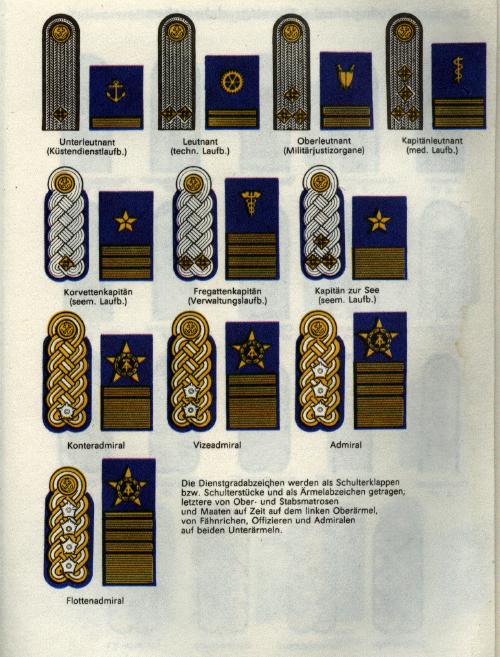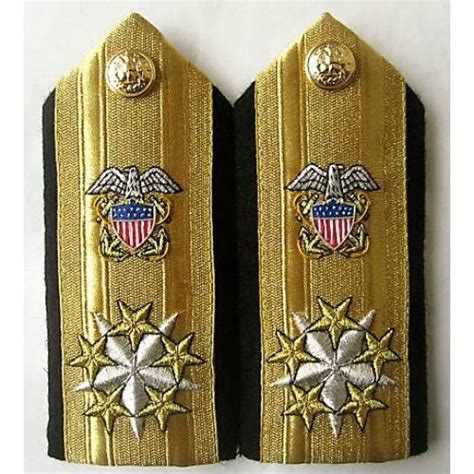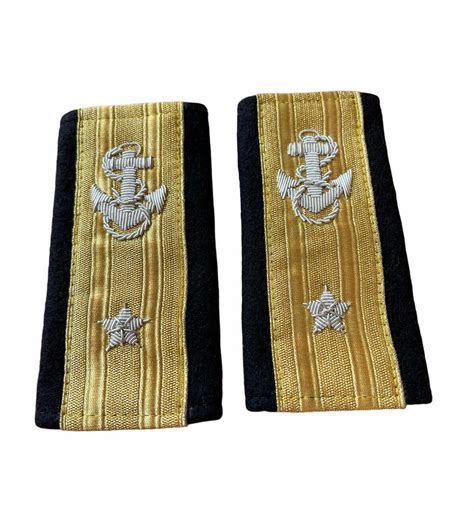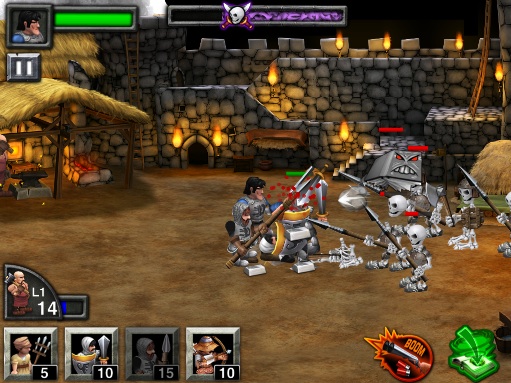Navy Shoulder Boards

Navy shoulder boards, also known as shoulder marks or rank insignia, are an integral part of naval uniforms, serving both a functional and symbolic purpose. These distinctive pieces of regalia have a rich history and play a crucial role in naval traditions and the hierarchy of the naval forces. In this comprehensive guide, we will delve into the world of navy shoulder boards, exploring their evolution, design, and significance in the modern naval context.
The Evolution of Navy Shoulder Boards

The concept of rank insignia dates back centuries, with early forms of uniform decorations being used to distinguish officers from enlisted personnel. The use of shoulder boards, however, has a more recent history, gaining prominence in the 19th century. The evolution of navy shoulder boards is a fascinating journey, reflecting the changing nature of naval warfare and the need for clear identification of rank and authority.
The Rise of Shoulder Boards in the 19th Century
During the 19th century, naval forces around the world began to adopt more standardized uniforms, including the introduction of shoulder boards. These early shoulder boards were often simple in design, featuring a strip of cloth or metal affixed to the shoulder of the uniform. The color and style of the board indicated the rank of the officer, with different colors and patterns used to distinguish between various ranks.
For instance, in the British Royal Navy, the use of gold lace on the cuffs and collars of uniforms became a distinctive feature, with the width of the lace indicating the officer's rank. This practice, however, was not without its challenges. The intricate lacework was time-consuming to produce and required skilled artisans, making it a costly affair. As a result, simpler alternatives, such as shoulder boards, began to gain popularity.
World Wars and the Standardization of Insignia
The outbreak of World War I brought about significant changes in the design and use of naval uniforms. The need for efficient identification of rank and authority became even more critical as naval forces expanded and operations became more complex. During this period, many navies standardized their rank insignia, adopting more consistent designs for shoulder boards.
For example, the United States Navy introduced a new system of rank insignia in 1917, which included distinctive shoulder boards for each rank. These boards featured a combination of stars, stripes, and gold or silver braid, making it easy to identify an officer's rank at a glance. This standardization not only improved efficiency but also boosted morale, as it clearly defined the hierarchy and structure of the naval force.
Post-War Innovations and Modern Designs
The post-World War II era saw further innovations in the design of navy shoulder boards. With the advancement of technology and the changing nature of naval warfare, the need for more practical and functional uniforms became apparent. This led to the development of new materials and designs, incorporating features such as improved durability, comfort, and visibility.
One notable example is the introduction of embroidered rank insignia, which replaced the traditional metal or cloth versions. Embroidered shoulder boards offered a more durable and flexible option, allowing for easier maintenance and customization. Additionally, the use of reflective materials and high-visibility colors became common, ensuring that naval personnel could be easily identified, even in low-light conditions.
Design and Symbolism of Navy Shoulder Boards

Navy shoulder boards are more than just decorative elements; they are a symbol of rank, authority, and tradition. The design and symbolism of these insignia vary across different naval forces, reflecting their unique histories and cultures. Understanding the intricacies of these designs provides valuable insights into the values and traditions of naval service.
Rank Indicators and Insignia
The primary function of navy shoulder boards is to indicate an officer's rank. The design and placement of various elements on the board convey specific information about the officer's position and authority. For instance, the number of stars, stripes, or bars often signifies the rank, with higher ranks being denoted by a greater number of these symbols.
Additionally, the use of different colors and materials adds further distinction. Gold or silver threads, for example, are commonly used to signify officer ranks, while enlisted personnel may have different color schemes or simpler designs. These visual cues allow for quick and easy identification, ensuring that the chain of command is maintained and respected.
National and Naval Symbols
Navy shoulder boards often incorporate national and naval symbols, adding a layer of cultural and historical significance. These symbols can range from emblems and coats of arms to more abstract representations of naval traditions. For instance, the Royal Navy's shoulder boards feature the iconic fouled anchor, a symbol dating back to the 16th century, representing the navy's connection to the sea and its rich history.
Similarly, the United States Navy's shoulder boards often include the national eagle, a symbol of strength and freedom. These symbols not only serve as a reminder of the naval force's heritage but also instill a sense of pride and patriotism among its members. By wearing these symbols, naval personnel carry the weight of their nation's history and values, reinforcing the importance of their service.
Materials and Durability
The materials used in the construction of navy shoulder boards have evolved over time, reflecting advancements in technology and the need for practical uniforms. Early shoulder boards were often made from cloth or metal, which, while visually appealing, could be prone to wear and tear. Modern shoulder boards, however, are typically made from durable synthetic materials, ensuring longevity and ease of maintenance.
For example, the United States Navy's modern shoulder boards are made from a combination of polyester and cotton, providing a balance between durability and comfort. The use of synthetic materials also allows for the incorporation of reflective elements, enhancing visibility and safety, especially in emergency situations. These practical considerations ensure that naval personnel can perform their duties effectively, without being hindered by their uniforms.
Navy Shoulder Boards in Modern Naval Operations

In today's naval forces, shoulder boards continue to play a vital role, serving as a practical and symbolic element of naval uniforms. With the increasing complexity of naval operations and the need for efficient communication and identification, the design and use of shoulder boards have adapted to meet these challenges.
Practicality and Functionality
Modern navy shoulder boards are designed with practicality in mind. The use of lightweight, durable materials ensures that these insignia do not hinder the wearer's mobility or comfort. Additionally, the placement of the boards on the uniform is carefully considered, ensuring that they do not interfere with essential equipment or impede the wearer's vision.
For instance, the United States Navy's shoulder boards are typically worn on the epaulets of the uniform, allowing for easy visibility and identification. This placement also ensures that the boards do not restrict the wearer's movement, as they are positioned away from the arms and shoulders, which are crucial for carrying out various naval tasks.
Visibility and Identification
The visibility of navy shoulder boards is a critical aspect, especially in high-stress or low-light conditions. Modern designs often incorporate reflective materials and high-visibility colors, ensuring that officers can be easily identified, even in challenging environments. This is particularly important during emergency situations, where clear identification of rank and authority can be a matter of life and death.
Furthermore, the use of standardized rank insignia across naval forces allows for better cooperation and communication during joint operations. When naval personnel from different countries work together, the ability to quickly identify each other's rank and authority is essential for effective collaboration and the smooth execution of missions.
Tradition and Morale
Navy shoulder boards are not only practical but also deeply rooted in naval tradition. The wearing of these insignia instills a sense of pride and camaraderie among naval personnel, connecting them to a rich history and shared values. The sight of officers proudly displaying their rank and insignia serves as a powerful reminder of the honor and responsibility that come with naval service.
Additionally, the tradition of wearing shoulder boards helps to foster a sense of unity and camaraderie among naval personnel. The shared experience of donning these insignia and the understanding of the rank structure create a strong bond between officers and enlisted personnel. This sense of community is essential for maintaining high morale and a cohesive naval force.
The Future of Navy Shoulder Boards

As naval forces continue to evolve and adapt to new challenges, the design and use of shoulder boards will likely undergo further transformations. With advancements in technology and the increasing importance of sustainability, we can expect to see innovations in the materials and designs of these insignia.
Sustainable Materials and Manufacturing
The naval forces of the future will likely place a greater emphasis on sustainability and eco-friendly practices. This may lead to the development of shoulder boards made from recycled or biodegradable materials, reducing the environmental impact of naval uniforms. Additionally, the use of more efficient manufacturing processes could further minimize the carbon footprint associated with the production of these insignia.
Enhanced Visibility and Safety
With the increasing focus on safety and emergency preparedness, navy shoulder boards may incorporate even more advanced visibility features. The use of smart materials or embedded sensors could provide real-time data on the location and status of naval personnel, enhancing safety and communication during emergency situations. These innovations could prove crucial in improving the overall effectiveness and responsiveness of naval operations.
Integration of Digital Technologies
The integration of digital technologies into naval uniforms is another area of potential innovation. Shoulder boards could be enhanced with digital displays, providing real-time information on rank, qualifications, and mission-critical data. This would not only improve efficiency but also reduce the need for physical rank insignia, potentially simplifying the uniform and reducing maintenance requirements.
What is the significance of the color gold in naval shoulder boards?
+The color gold holds great significance in naval shoulder boards, often representing officer ranks. Its use dates back to the early days of naval uniforms, where gold lace or embroidery was used to signify an officer’s rank and authority. The color gold is associated with prestige, elegance, and distinction, making it a fitting choice for naval officers.
How often are navy shoulder boards updated or redesigned?
+The redesign or update of navy shoulder boards varies depending on the naval force. Some navies may update their insignia every few decades to reflect changing traditions or modern advancements, while others may maintain a more conservative approach, keeping the design consistent for extended periods. These decisions are often influenced by cultural, historical, and practical considerations.
Are there any regulations regarding the display of navy shoulder boards?
+Yes, there are strict regulations governing the display of navy shoulder boards. These regulations outline the proper placement, size, and design of the insignia, ensuring consistency and uniformity across the naval force. Officers must adhere to these regulations, as the shoulder boards are not only a symbol of rank but also a representation of the naval tradition and values.



